 General
General  General Archive
General Archive  The Sports World According to Atari
The Sports World According to Atari
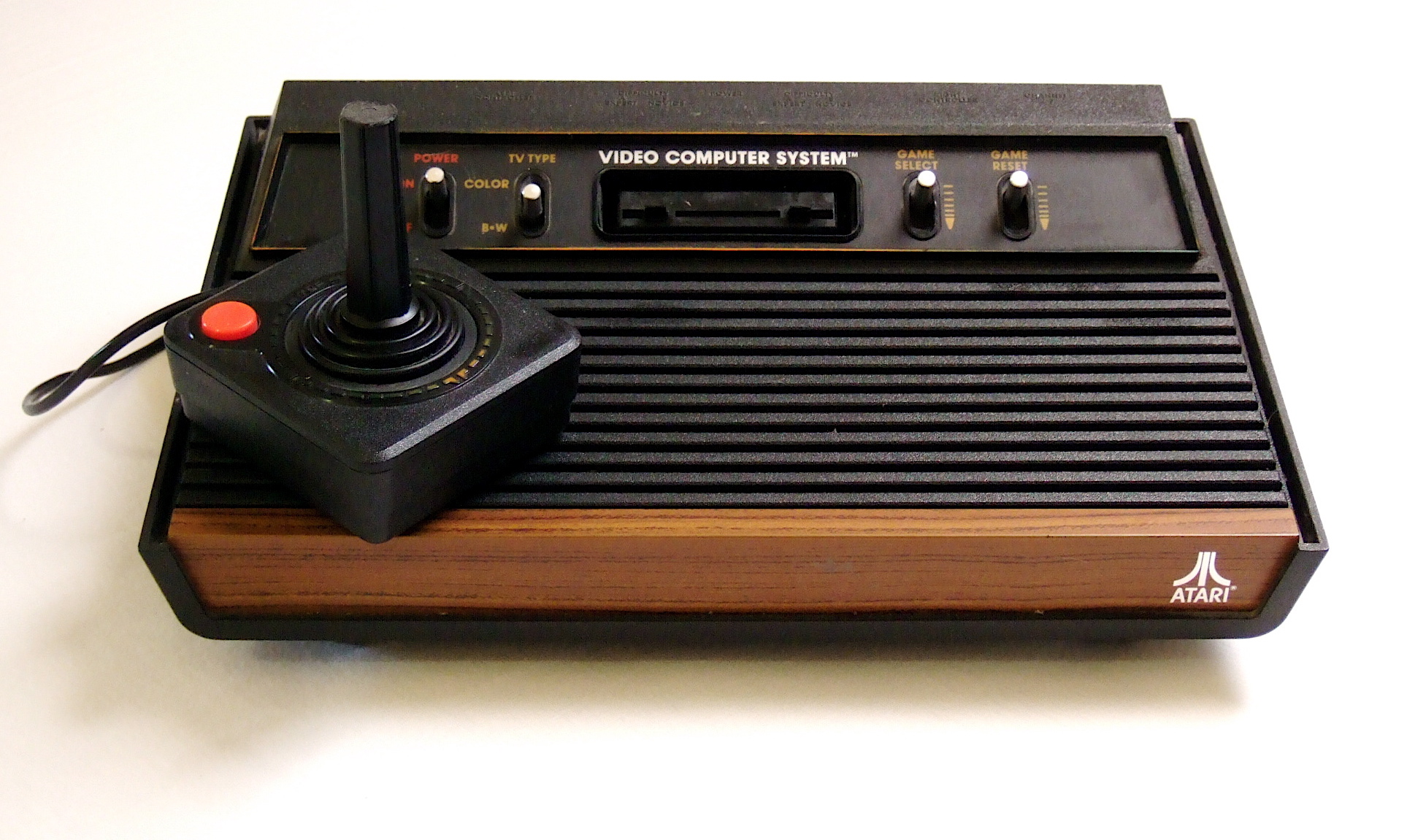 With this week’s release of the latest EA Sports masterpiece, NCAA Football 13, to which more effort and attention was put into than California’s state budget, those of us born prior to The Last Starfighter find ourselves shaking our heads, literally dumbstruck.
With this week’s release of the latest EA Sports masterpiece, NCAA Football 13, to which more effort and attention was put into than California’s state budget, those of us born prior to The Last Starfighter find ourselves shaking our heads, literally dumbstruck.
The graphics and animation are terrifyingly good. Each team’s roster and stadium design mirror actuality down to the wainscoting and nose hairs. Not only can you play out entire seasons with any Division I team in the country - keeping records and statistics along the way - but you can build “dynasties,” playing multiple seasons while adding new players and building a program into a national power.
At this point, the series is closer to real college football than watching an actual game involving a team from the Big Ten.
And of course, this is just the plate of mozzarella cheese sticks to nibble on while you wait for the main course. Fresh off ruining Peyton Hillis’ career, EA’s “Madden” series spits out its 2013 edition next month, no doubt also better than ever.
Each time EA Sports cranks out a new game, we can appreciate how our grandparents felt when Neil Armstrong hop-scotched across the moon. If you can remember a time when owning a cordless phone was a big deal, watching somebody play the latest version Madden is like seeing The Jetsons come to life.
For I, like many of you, grew up in the stone age of home video game entertainment, in a time when the eight-bit, Super Mario-Nintendo system was as futuristic as a flying car. Those were dark, ancient times when you actually had to go over to somebody’s house to play with them and get up off the bean-bag chair to turn the knob to channel 3 (or 2, depending on where you lived). It was an era defined by a word that to today’s youth sounds like a half-stifled sneeze:
Atari.
That shoebox-sized black rectangle (with lovely fake wood paneling across its base) that sat atop your console television that itself was the size of a modern HVAC system. Beside it rested the one-button “joystick,” with all its phallic connotations that we didn’t yet understand. And littered all around were the small, wallet-sized cartridges that contained all the deliciously simple electronic enjoyment we could ever want.
If you showed screenshots of the games within any of these cartridges to your kids today, they’d start to cry. But for us, Space Invaders and Donkey Kong were cutting-fucking-edge.
You could go on for days comparing those original Atari games to their modern descendants, but I think the dichotomy becomes particularly stark when you limit your comparison to Atari’s sports games and the sports games of today.
Here are the most memorable ones that defined a generation of young sports junkies:
 Basketball
Basketball
Simple as it gets: a purple player (with the body structure of a burn victim) and a yellow burn victim went one-on-one, each trying to chuck a peppermint Tic Tac at the cross on which Jesus died for our sins.
Why Pac-Man Loved It: There was a running clock and the game kept score for you, which in 1978 was the balls.
Why Pitfall Hated It: You could pass the ball to yourself - setting a precedent the NBA will undoubtedly soon be incorporating.
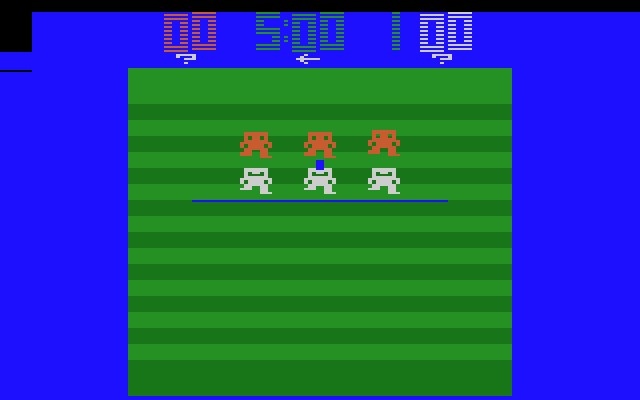 Football
Football
Perhaps better remembered as a tabletop arcade game you’d play against your brother while you waited for your pizza, this was also a big staple once the Atari home system hit major circulation. This was Kansas-high school-style three-on-three football: the ball would be snapped to the player in the middle and he would meander listlessly in the backfield, trying to avoid the equally meandering pass rushers. When you found one of your other two teammates open, you’d press the button (the lone button, kids - none of this A, B, Z, L, R, Q, Epsilon button hootenanny) and fire a pass toward him. And in a slight deviation from real life, you could control the pass after it was thrown, steering it gradually around any would-be defenders.
Why Pac-Man Loved It: On each play, there was a thin blue line representing the point you needed to reach for a first down - created some 20 years before FOX and CBS had the same idea.
Why Pitfall Hated It: Each of the six players had the body shape of Tik-Tok, the robotic Royal Army of Oz.
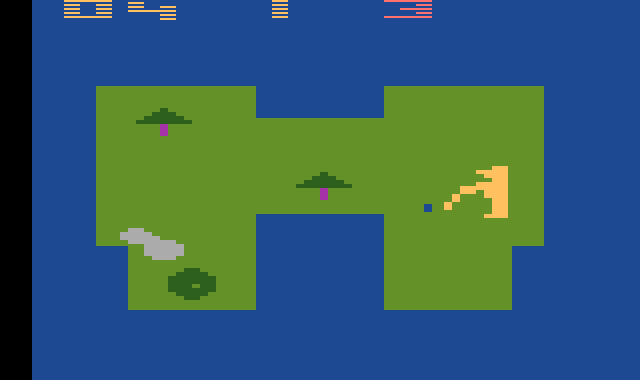 Golf
Golf
Not unlike actual golf, this game would piss you off four seconds into the experience. A disproportionately immense yellow figure would float around the ball winding up a swing with a counter-clockwise twirling motion, then lightly tap the ball in a wayward direction. After seven or eight increasingly frustrating taps, you’d “hit the green” and get to another screen, then try to whirligig the ball into the hole.
Why Pac-Man Loved It: This game served as the first draft of the Happy Gilmore script.
Why Pitfall Hated It: Evolutionarily speaking, it has to take some responsibility for all the money we’ve lost playing Golden Tee.
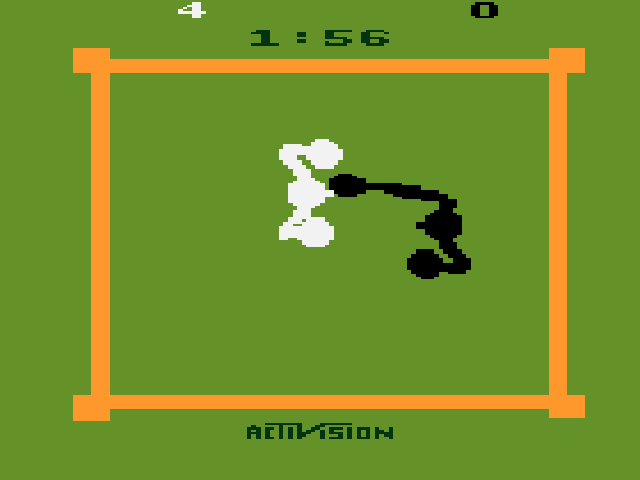 Boxing
Boxing
Taking the necessarily insane viewpoint of above the ring looking down, this one contained immediately apparent racial undertones as each match pitted a lily-white boxer against an ebony-black one (each built like Grover from Sesame Street). You’d fire punches with a surprisingly smooth delivery for 1980 software technology, and each connected punch coincided with a shotgun-blast sound effect that I really hope isn’t what boxers hear in their heads.
Why Pac-Man Loved It: Fully extended, the boxers’ arms were longer than their entire bodies.
Why Pitfall Hated It: The lack of legs or feet, such a huge part of actual boxing, probably played a notable role in the sport’s pay-per-view downfall.
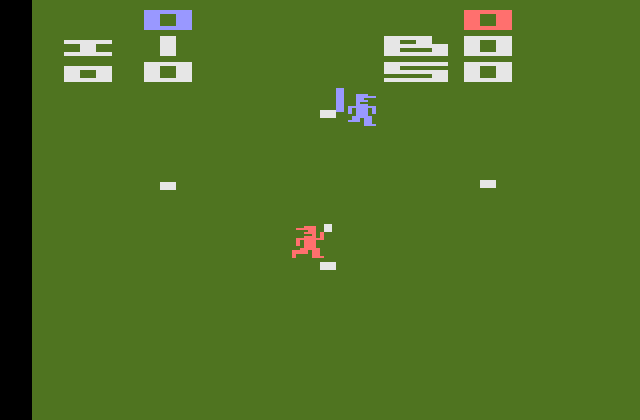 Home Run
Home Run
Playing this one against the computer made you appreciate what it must have been like to hit against Bob Gibson. As a tiny mangled batter (though distinctly wearing a baseball cap), you’d flick your bat at a wildly corkscrewing ball in a desperate attempt to make any kind of contact. No matter where or how hard it was hit, the ball would be retrieved by the pitcher - the only defender - who would then demonstrate the speed of a demonic cheetah on as he’d float across the screen to touch first base before your batter did.
Why Pac-Man Loved It: You could hit opposing batters in the face with a pitched ball with complete impunity.
Why Pitfall Hated It: Basically your only chance for getting on base was to hit a ball so hard the 128 bytes of software juju within the system couldn’t react and the ball would float off the screen for either a home run or a ground-rule double, depending on what mood your Atari was in.
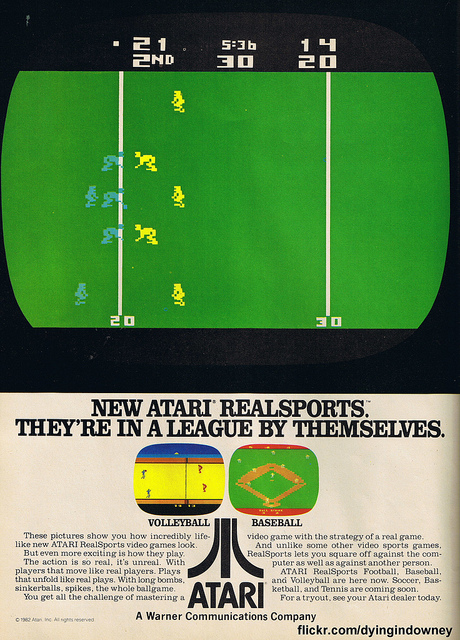 The RealSports Series
The RealSports Series
In 1982, Atari upgraded its sports universe with its “RealSports” launch, creating new versions of old classics (baseball, football, and boxing) while introducing others that no one played (soccer, volleyball, and tennis).
Why Pac-Man Loved It: Though today these games look like something any Pixar designer would whip up while sitting on the toilet, the result was a much more fluid and yes, more realistic version of each game.
Why Pitfall Hated It: Sadly, while the overall look and feel improved, the quality of the gameplay did not, reaffirming the overarching theme of video games: more realistic does not necessarily mean better.
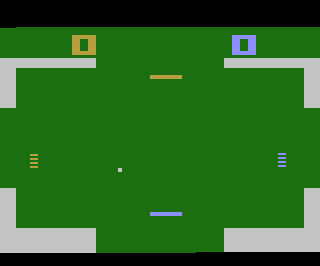 Video Olympics
Video Olympics
The “Combat” of Atari sports games - 10 “different” games that never actually claimed to be anything other than Pong with more crap in your way.
Why Pac-Man Loved It: No opening ceremonies, closing ceremonies, bomb detonations, or hostage situations.
Why Pitfall Hated It: You had to use the paddles and that almost always sucked.
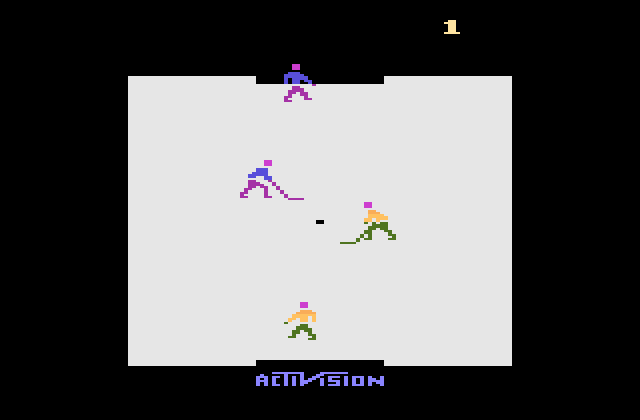 Ice Hockey
Ice Hockey
In an infrequently used two-on-two situation, you’d try to control the puck (generally by beating the shit out of your opponent with your stick until he crumpled to the ice), then maneuver down to spike the puck into the goal (in this case a black void the size of a loft apartment in Greenwich Village) as the goalkeeper tried in vain to beat the shit out of you with his stick.
Why Pac-Man Loved It: This was one of the rare Atari sports games in which it was actually more of a challenge to play the computer rather than a friend. (Which, I’m sure most of us who remember these games had to do more often than we’d like to admit.)
Why Pitfall Hated It: Each goal was accompanied by a metallic beeping sound that today we relate as an indicator that the lethal-execution fluid has just been injected.
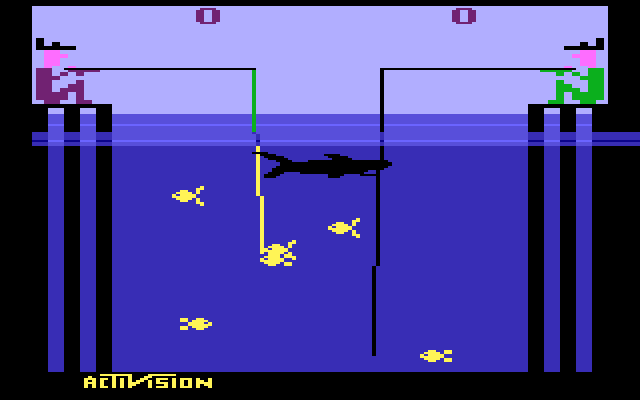 Fishing Derby
Fishing Derby
Two Ichabod Cranes sitting on facing docks sink their lines into the water and try to pull up wiggling fish before they can be eaten by a disturbingly prescient shark that made Jaws look like the Incredible Mr. Limpet. The closer to the bottom the fish were, the more points you got when you pulled them up (not sure if there’s a life lesson there). First one to 99 points wins.
Why Pac-Man Loved It: There’s a killer shark swimming six inches beneath the water right next to a public fishing dock.
Why Pitfall Hated It: The sudden, electronic “chomp” sound when a shark ate one of your fish would haunt your dreams and eventually send you to analysis.
 Miniature Golf
Miniature Golf
Though the design was incomprehensible (each screen looked like a cross between a petrie dish experiment and the Map Room from Raiders of the Lost Ark), this was actually a far more enjoyable game than regular Atari Golf. Controlling a mobile blue liver spot, you’d maneuver the ball toward the hole, trying to avoid a moving pink blob that would smack the ball halfway to hell.
Why Pac-Man Loved It: It programmed you to begin unconsciously calculating crazy angles - which would later pay off in billiards, dating, and Second Life.
Why Pitfall Hated It: No windmills.
After going through this list, I’m sure I’m not the only one who suddenly needs a cup of Tang and a big bowl of Bugles - two other things these kids today just wouldn’t understand.
But that’s not to rip on the children of 2012 and the state of their electronic entertainment. I’ll be the first to admit that the video games of today are a thousand times more impressive or addicting than the ones we played and can understand why kids would (and do) want to play them every waking second.
Be that as it may, nothing cranked out by EA or anyone else since has ever put as much joy in my joystick.
- NBA Announces 2013-2014 Schedule
- Browns Ink Sharknado
- Sharknado A No-Show For Rookie Camp
- Trent Richardson Out Until Training Camp
- Browns Sign Brandon Jackson
- Carrasco Suspended Eight Games
- Browns Add to Wide Receiver Depth with David Nelson
- Browns Need to Learn from Past Draft Mistakes
- Browns Release Chris Gocong and Usama Young
- Browns Missing on Grimes Disappointing, But Not The End
The TCF Forums
- Official- Browns Coach Search/Rumors
HoodooMan (Tuesday, January 21 2014 1:32 PM) - Movies coming out
rebelwithoutaclue (Tuesday, January 21 2014 12:56 PM) - 2015 Recruiting
jclvd_23 (Tuesday, January 21 2014 12:38 PM) - The 2014 Offseason Thread
Larvell Blanks (Tuesday, January 21 2014 12:25 PM) - Chris Grant's first 3 drafts
Kingpin74 (Tuesday, January 21 2014 10:13 AM) - Mike Brown
YahooFanChicago (Monday, January 20 2014 11:15 PM) - 2014 Hoops Hockey Hijinx
jpd1224 (Monday, January 20 2014 4:44 PM) - 2014 Recruiting
jclvd_23 (Monday, January 20 2014 2:26 PM) - Wish List - #4 Pick
Hikohadon (Monday, January 20 2014 1:26 PM) - #1 overall pick Anthony Bennett
TouchEmAllTime (Sunday, January 19 2014 1:28 PM)


